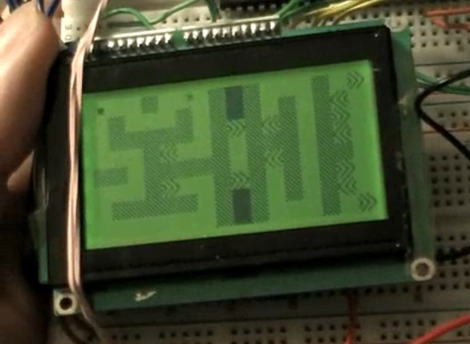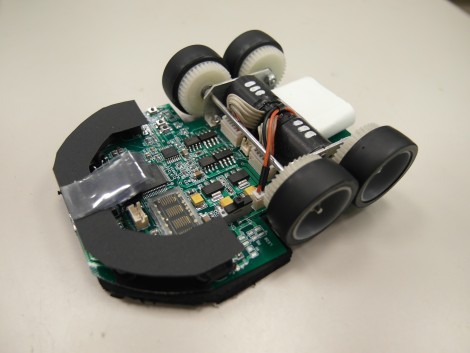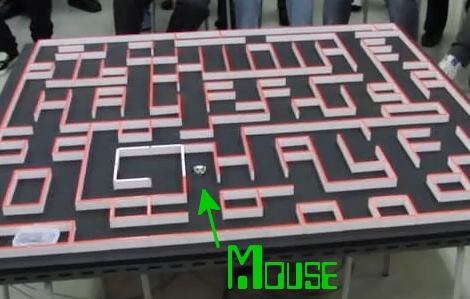Go Vote Now! update: looks like the vote button opens a popup to a Facebook app. this is required to vote :(
For the full writeup on our entry, go here!
Continue reading “Voting Is Open For The Red Bull Creation Contest. Go Team Hackaday!”
Go Vote Now! update: looks like the vote button opens a popup to a Facebook app. this is required to vote :(
For the full writeup on our entry, go here!
Continue reading “Voting Is Open For The Red Bull Creation Contest. Go Team Hackaday!”

[M. Eric Carr] built this a long time ago as his Senior Project for EET480. It’s an electronic version of the ball-in-maze game. We’ve embedded this video after the break for your convenience.
The game has just one input; an accelerometer. If you’re having trouble visualizing the game, it works the same as this Android-based version, but replaces the physical maze and marble with a virtual maze on the graphic LCD screen. This has huge implications. Instead of just recreating the maze on the screen, [Eric] designed a multi-screen world, complete with warp blocks, which adds difficulty to finding a solution. It also means that multiple different mazes can be played if you get tired of playing the same level.
This game also features music. A separate PIC microcontroller uses PWM to push out the 8-bit sound heard in the video. From the YouTube comments we learned that [Eric] didn’t write the music himself, but we still appreciate the playback quality he achieves with his hardware.
Continue reading “Ball-in-maze Game Shows Creativity And Classic 8-bit Sound”

It’s off to the races once again with the Micomouse maze solving contest at the 2011 RoboGames. This is a picture of the winner, a bot called Min7 (main page) which was built by [Ng Beng Kiat]. Using four phototransistors and a flash sensor it managed to first map the contest maze, then speed run it in under four seconds. See both runs in videos after the break. He’s certainly got a leg up on the bots we saw last year. Min7 beats them both in time, and overall control during the speed run.
[Ng] mentions that this year is the first time he’s built a micromouse with four wheels instead of two. There’s a gyro on board which aids navigation by feeding the orientation data to the STM32 chip which controls the device. We took a moment to page through his past designs. It’s remarkable how they’ve evolved through the years. Continue reading “Micromouse Wins 2011 Maze Race In Under 4 Seconds”

[Oskar] has been making puzzles for some time now. In 2000, he made a small electromechanical 4-bit maze that’s really fun to play. Lately though, he’s been working on an improved version that could be the beginnings of a commercial product.
The earlier electromechanical maze (you can play it in an applet on that page) is just a microcontroller hooked up to electromagnets and switches. To complete the maze, find the patterns of bits that move everything from 0 to 1. It’s a little bit like the Fox Chicken Grain puzzle, only a bit more complicated.
[Oskar]’s latest version uses motorized faders to represent the 0 and 1 states of the bits. The same logic in the electromechanical version is in the newest version. An Ardunio takes care of the motor control and game logic.
As a tiny logic game toy, it’s a great idea; everybody needs to get some hands-on action with Karnaugh maps sometime in their life. Check out the video below for the demo of the 4-bit maze in action.

In what is surely becoming an ever-growing Rube Goldberg machine, [Dan] updated his gum ball dispenser to include a robot arm. We looked in on this human lab-rat experiment that rewards successful maze navigation with bubble-gum just about a year ago. As you can seen in the video after the break he’s added several new features to delight users. The original had a maze actuated by an accelerometer and that remains the same. But when the device fires up, the wooden ball is moved to the start of the maze by a Lynxmotion robotic arm. That arm is mounted on rails so it can also move to deliver the gum ball after a successful run. There’s also an anti-jamming feature that shakes the gum ball dispenser to ensure you don’t come up empty.
Whether playing chess or being controlled by a mouse the Lynxmotion has been quite popular lately. [Dan’s] solution uses a vacuum pump to grab onto the spheres (both wooden and gum), similar to the method used with the CNC pick and place from a while back.

Looking for something to build that will be challenging and interesting to laypersons at the same time? Take some inspiration from this maze-solving robot mouse. It take the idea of a line-following robot, and makes it infinitely more cool. The tiny rover uses sensors to map out a physical maze. Once it figure it out, you put it back at the beginning for a speed run to the finish. We’ve embedded the video below showing the whole process. Looks like the speed-run is completed in just under five seconds.
Now that you’ve enjoyed a virtual mouse in a real maze, check out a real mouse in a virtual maze.
[youtube=http://www.youtube.com/watch?v=63Txt5rLSWU]
[Mitchel Humpherys] and his fellow developers didn’t just develop a maze-solving algorithm, they also built a ping-pong ball maze platform that is computer controlled. Using a webcam the computer picks up the high-contrast maze by peering down from above, calculates the solution, and moves the ping-pong ball to the goal using two different tilt servos controlled by an 8051 microcontroller. But wait, there’s more! Why have the computer solve it when you can make a game out of a maze? Once the PC was thrown into the mix it was pretty easy to add Wii remote and Wii balance board control too. See these alternative inputs in action after the break.